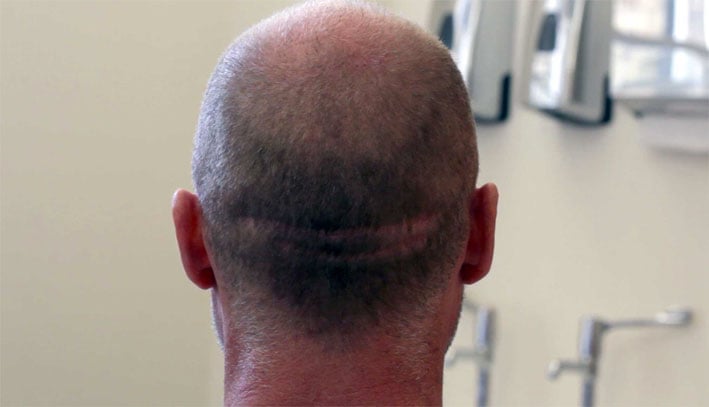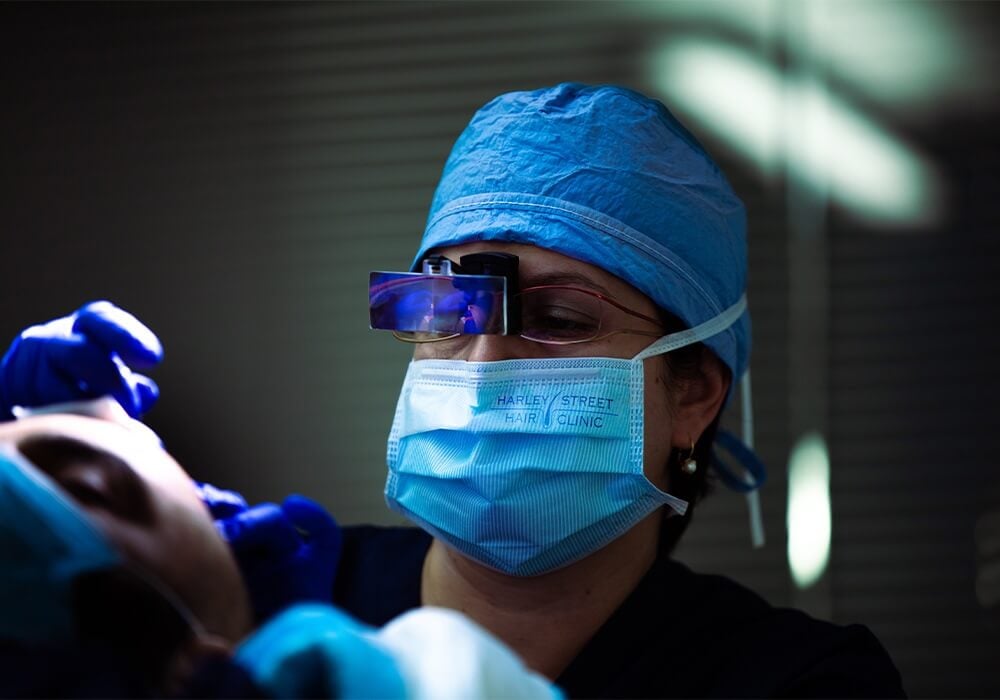Hair scar repair is a specialised technique that uses the FUE hair transplantation method to conceal scars, typically on the scalp. People may have scars for all sorts of reasons, such as due to injuries, burns, birthmarks, or even after getting a FUT hair transplant, which leaves more scarring compared to FUE. These scars can cause self-image issues, especially if they are noticeable, and having a solution like hair scar repair can massively increase a person’s self-confidence.
The main method used for hair scar repair is a FUE hair transplant, which transplants healthy hair follicles into the scarred tissue. However, there’s also the option of using Advanced Tricho Pigmentation (ATP), a method that involves using pigmentation to mimic the look of hair follicles.
Both of these methods are minimally invasive and lead to natural-looking results, and are an effective way to camouflage scars while making your hair appear denser.

How Hair Scar Repair Works
We’ll go into two methods here: the FUE scar repair method as well as the Advanced Tricho Pigmentation route – both of which we offer here at Harley Street Hair Clinic.
FUE Hair Transplant Repair
The FUE hair transplant scar repair method begins by taking donor hair from the scalp or the body, with it typically being taken from the back or sides of the scalp, where the hair is often the densest. The donor hairs are then prepared by the surgeon as they extract the individual hair follicles, ready for transplantation. From there, the hair follicles are implanted carefully into the scar tissue and angled to mimic hair growth, achieving completely natural results.
Advanced Tricho Pigmentation Repair
ATP is an alternative method that doesn’t involve transplanting hair at all. Instead, it uses pigment to cover the scar tissue. The technician uses specialised equipment to deliver tiny, microscopic dots on the scar tissue, adjusting the pigment and depth as they go and creating the illusion of hair follicles. When enough of the dots are created, it looks like a shaved head. The result is that the scar is effectively camouflaged, with the ATP blend appearing completely undetectable.
Who is a Good Candidate?
If you have noticeable scar tissue on your scalp, you may be wondering if you are a good candidate for our scalp scar camouflage techniques. Here are some of the most common reasons people get either FUE or ATP hair scar repair – if one of these applies to you, there’s a high chance you would make a fantastic candidate.
- FUT Scars: FUT (follicular unit transplantation) is a method of hair transplantation that can leave noticeable scars (unlike FUE). As such, many patients choose to get FUE or ATP to cover up these scars for a more natural look. This is also called FUT scar correction.
- Injury Scars: Many types of injuries can lead to noticeable scarring, such as injuries from sports accidents.
- Burns: Burns can leave significant scarring on the scalp, and FUE or ATP scar repair can help conceal these.
- Birthmarks: Some people are born with birthmarks on their scalp and want to cover them with hair scar repair.
- Inflammatory Diseases: Certain inflammatory diseases, such as scleroderma, can lead to scar tissue on the skin.
Factors Affecting Suitability
Unfortunately, not everyone can get FUE or ATP scar repair, as there are some factors affecting suitability, including the following.
- Scar Thickness: Sometimes, if the scar is too thick, FUE or ATP simply isn’t an option. For example, hypertrophic scars, which are raised and often lumpy, may be too difficult to treat with these scar repair methods.
- Blood Supply: There needs to be enough blood supply in the area for the hair follicles to survive – without it, they will simply fall out, and the process would have been for nothing.
- Skin Health: Your skin health plays a role in whether you can get scar repair treatment or not. If you have problems with the skin in that area, such as psoriasis, scar repair may not be a suitable option.
If you are unsure whether scar repair treatment is right for you, book a consultation with our team for an individual assessment. A scar repair specialist can assess your situation, looking at your scar and taking into account your medical history to determine whether you would make a good candidate.
The Benefits of Hair Scar Repair
Hair scar repair has already helped many individuals feel more comfortable in their skin. If you want to know if it’s worth it, here are some of the biggest advantages of the treatment.
- An Effective Camouflage: Both FUE and ATP provide an effective camouflage, hiding the scar with either real hair or the illusion of hair.
- Micro Methods: FUE uses a micro-surgical method that leaves minimal additional scarring, while ATP uses a tiny needle that creates microscopic dots. As such, they both lead to natural results.
- Able to Treat Multiple Locations: FUE and ATP scar repair can be used to hide scars in multiple locations on the body, including on the scalp, eyebrows, and sideburns.
- Minimally Invasive: Both FUE and ATP scar repair are minimally invasive – they are certainly less invasive than corrective FUT procedures, which involve techniques like excision and grafting to hide linear scars left by FUT hair transplantations.
Treatment Process & Comfort
We understand that booking a hair scar repair appointment is not always easy, especially if you are concerned about the treatment process – particularly how comfortable it will be. The good news is the team here at Harley Street Hair Clinic takes patient comfort and safety extremely seriously, and we use a variety of methods to ensure the patient feels at ease every step of the way.
- Use of Local Anaesthetic: We use local anaesthesia before both scar repair methods so that the process is completely pain-free.
- Micro-Surgical Techniques: The comfort levels for both methods are generally high, as micro-surgical techniques minimise discomfort.
- Number of Sessions: We will spread out the number of sessions depending on the scar size and method used.
- Recovery and Aftercare Guidance Provided: We always provide recovery and aftercare guidance to patients, including an aftercare package with detailed instructions and antibiotic treatments. This ensures your recovery goes smoothly and you heal as quickly as possible.
If you have any concerns about pain or comfort during scar repair, you can simply talk to our specialists. Voice any worries you have, and we will do everything we can to ensure you feel as comfortable as possible.
The Cost of Scalp Scar Camouflage
The cost of FUE or ATP scar repair treatment varies significantly, depending on factors such as:
- The Scar Size
- Density of the Grafts
- Number of Grafts
- Scar Complexity
- The Chosen Method (FUE or ATP)
If you want to know how much scar repair with us will cost you, simply book a consultation for a personalised quote.
Results
The results of scar repair depend on which method you use.
FUE Scar Repair
FUE takes time for results to show through. The first couple of weeks involve the recovery process, in which you might notice side effects such as minor swelling and scabbing. The first signs of regrowth show through after around three months, though, with full results showing after twelve months. From there, results last a lifetime.
It’s also worth noting that there may be some maintenance required for FUE scar repair if the treatment is used in an area where the hair stays short – in this case, trimming may be required.
ATP Scar Repair
The results of advanced tricho pigmentation for scars are pretty immediate! Almost instantly, you will see a visual improvement to the scars, as the pigment gets deposited during the treatment. In some cases, multiple sessions are required to build enough layers of pigment in a natural manner.
Scar Repair FAQs
Yes, it is possible to transplant hair onto a scar, and this is exactly what FUE scar repair does. However, it does depend on the scar’s characteristics – there needs to be enough blood supply for the method to work, for example.
Hair grafts can definitely survive in scarred areas. However, the survival rate depends on the health of the skin, the blood supply, and the thickness of the scar.
Both FUE and ATP scar repair treatments are permanent, with results lasting a lifetime. However, be aware that ATP’s results may become less vibrant as time goes on, as the pigment fades, so a top-up may be required.
ATP can be used alongside a hair transplant. In some cases, it can be used instead of a hair transplant, especially if the patient doesn’t want to grow long hair.
It depends on whether you choose ATP or FUE. You will see the results of ATP scar repair immediately; however, you’ll need to wait at least three months before you see the results of FUE.
Yes, it is possible to get ATP and FUE, as both methods work well together.
Book a Consultation for Scar Repair
At Harley Street Hair Clinic, we provide two effective methods for covering up scarring: ATP and FUE scar repair. Both of these methods work well for hiding scars, while also making the hair in that area appear denser. They are minimally invasive, can be used in multiple locations, and will last a lifetime.
If you want to learn more about our scar repair methods, simply book a consultation with us today. You can send photos for a personalised assessment, where our experts will determine which method is best for you.
